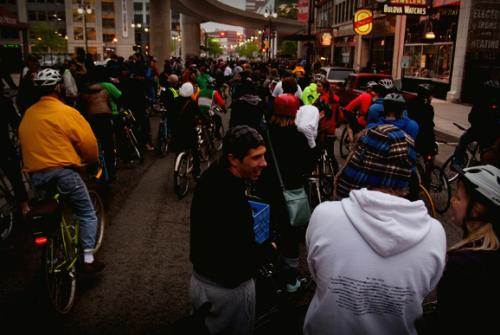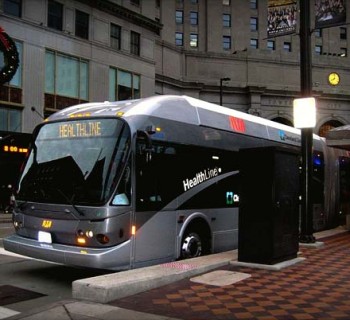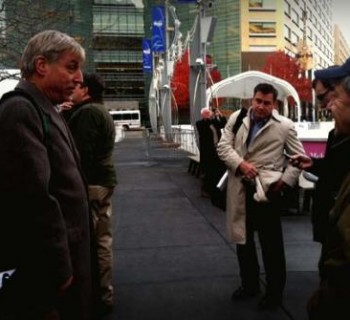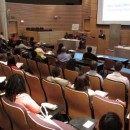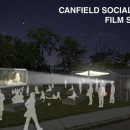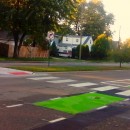DETROIT — Detroit’s Critical Mass is approaching a tipping point. Starting with just a handful of Detroit cyclists about seven years ago, the ride has swelled to include hundreds of riders from across the region as perceptions of Detroit as a more bike-friendly city increase.
Meeting in Woodbridge at the corner of Warren Ave. and Trumbull on the last Friday of every month, hundreds of riders now come to reclaim the streets, to spread bicycle awareness and to have a good time with their fellow cyclists. They wear anything from Lycra to cutoff shorts, and come mounted on adult tricycles, fixed gears, recumbents, cruiser bikes and the occasional unicycle.
Waiting to start the ride, some riders sip water and eat granola bars, others smoke cigarettes and sip whiskey. The smell of diesel exhaust from passing buses and trucks lingers in the air while riders chat with one another about their Friday night plans and the ride ahead.
Detroiter and regular Critical Mass rider Erin Ellis says the first time she rode there were only a handful of people. “We’ve all watched as Detroit and cycling have gained popularity in the last several years, and I'm glad that more people have now had a taste of what many Detroit cyclists experience on a daily basis.”
“Critical Mass allows folks who may not otherwise explore the city on bicycle to do so, instilling a confidence that the city is bikeable,” Ellis says. “Likely more so than their own suburban neighborhoods.”
Detroit’s Critical Mass uses a Facebook page to help organize the elusive community of over 1,900 riders grow, which traditionally has no organizer, mostly for the sake of not being able to hold anyone accountable for the ride.
Spectators call the ride a protest; riders see it as spreading awareness
Having no central organizer, detractors of the ride can’t hold any single person responsible for the unsanctioned rolling protest of sorts, which aims to make a statement against the automobile’s domination of the streets.
The ride’s meeting location and time seldom change: last Fridays of the month at 6 p.m. It happens regardless of who attends, rain, snow, or shine.
Typically an unorganized event, riders take turns leading the mass of cyclists. With everyone having varying standards of how the ride should take place, it’s hard to please everyone and can and does get hectic.
While hundreds of riders are hard to account for, the average pace is a forgiving and manageable 12-15 miles per hour and the group does take an occasional break.
“Critical Mass allows folks who may not otherwise explore the city on bicycle to do so, instilling a confidence that the city is bikeable,” Ellis says.
To ensure the safety of the assemblage of cyclists, more experienced Critical Massers will help “cork” during the ride. Corking is the practice of riding ahead of the group and blocking cars at any and all intersections, ensuring traffic doesn’t interfere with the ride, both for safety and in homage to the ride’s purpose. Generally about 15-20 people will help cork during a ride, and will stay parked at the intersection until the entire group has passed.
Drivers tend to find this practice particularly annoying, especially when a corker claims sarcastically to drivers that it will take “just one minute!” Drivers then watch hundreds of riders pass, sometimes stopping traffic for up to ten light cycles.
Critical Mass isn’t for everyone; especially if you’re not riding
Critical Mass has been criticized, however, by everyone from motorists to other cyclists and for a number of reasons including accusations the ride is meant to gum up traffic. Some say the ride, which takes place nation- and world-wide, gives cycling a bad name because many of the riders typically do not obey traffic or cycling laws.
“I would suggest the Detroit ‘Critical Mass’ ride is really just a fun, social Tour de Troit ride without the police and registration,” says Michigan Trails and Greenways Alliance Coordinator Todd Scott. “We shouldn't kid ourselves that this event focuses on making political change in the city of Detroit.”
Scott says the ride also seems to attract a lot of suburban riders. “The battle for space and respect is in the suburbs, not Detroit. A suburban Critical Mass at rush hour has the potential to raise awareness and possibly force changes,” he says.
Ellis says she finds value in the Detroit ride, however. While she’s noticed the criticism towards people who drive their cars from the suburbs to ride, she thinks inspiring people to ride in the city has been one of the more positive outcomes.
Despite criticism, Detroit’s Critical Mass has been successful at attracting more and more riders. It has also inspired a Suburban Detroit Critical Mass, which leaves from Royal Oak, and is now also hundreds of members strong.
Other group rides inspired by and for cycling and awareness include the annual Tweed Ride and Fender Bender’s Full Moon Bike Ride.
According to Laura Buhl of the City Planning Commission, the City Council has no official position on the ride, but it’s clear cyclists have the city’s attention. Detroit currently has a complete streets ordinance under review, which will likely pass in the next year.
Councilmember Kenneth Cockrel, Jr., an avid cyclist, says he’s likely to sponsor it as it aligns with goals and objectives of his Green Task Force.
Sanctioned and approved of or not, Detroit's Critical Mass will continue to happen. As the ride continues to grow, there's not a doubt that more people are being exposed to what riding in the city is really like, and how hundreds of people riding on a daily basis might help inspire even more to ride.
See more photos from Detroit Critical Mass on Mode Shift's Flickr page.


